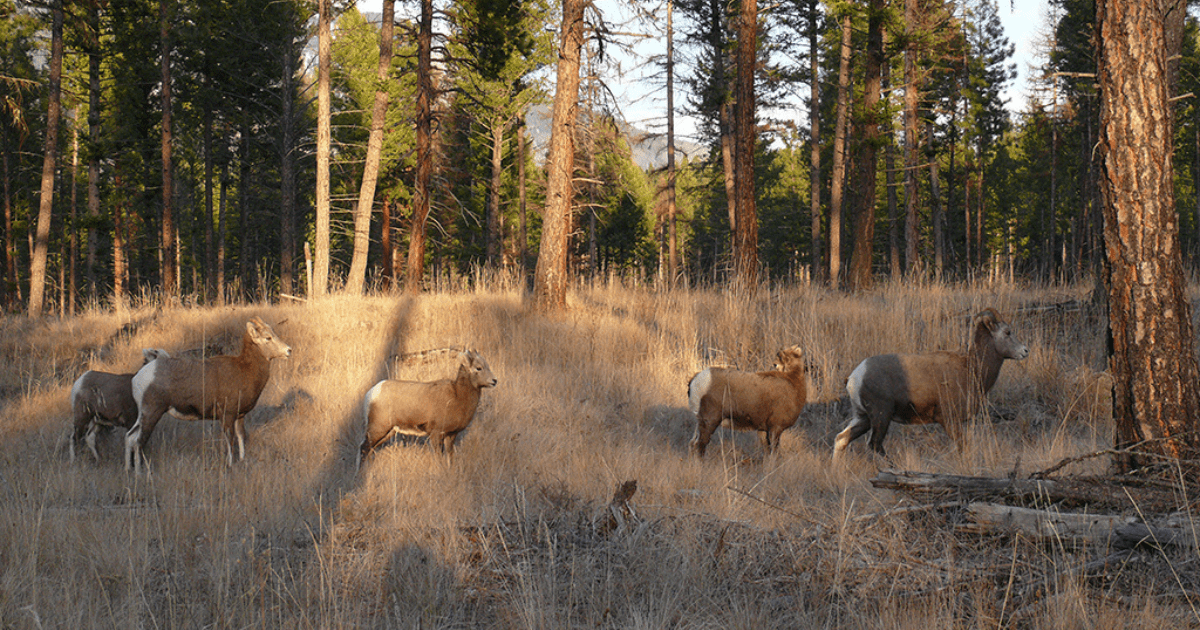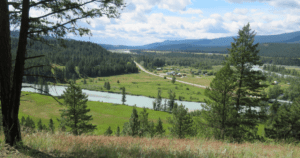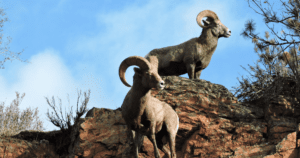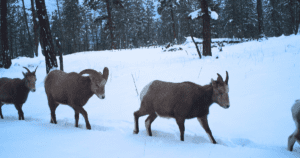
In the Kootenays, The Nature Trust of British Columbia and its partners are boosting biodiversity by restoring and enhancing habitat through forest thinning. The new six-year project, known as the Bull River Grassland Corridor Habitat Enhancement Project, will help support a greater diversity of plant species, reduce wildfire risk, increase habitat quality and connectivity, and help wildlife thrive.
The Case for Connectivity in the Kootenays
Historically, the Bull River area has been one of the most significant wildlife habitat sites in the East Kootenay, providing winter range habitat for iconic Canadian ungulates like Bighorn sheep, elk, deer and moose. As temperatures drop and snow begins to accumulate , many species must migrate to into the valley bottom with more hospitable conditions to survive the winter.
As human development has progressed in the area, the species that rely on Bull River are faced with challenges that affect their ability to move and migrate freely. High fences on private land reduce habitat connectivity, making it difficult for wildlife to travel between the Kootenay River valley and the Rocky Mountains. These barriers to habitat connectivity in the Bull River area mean that designated conservation areas and protected wildlife corridors are more important now than ever to bolster biodiversity in the region.
The Nature Trust, together with the Province of B.C., has been working for decades to conserve land in the Bull River area, boasting nearly 600 hectares that comprise the Bull River Conservation Complex. A critical conservation area within the complex is the 69.6-hectare Bull River Grassland Corridor, which provides an important grassland and open forest corridor between other conservation areas and public and private lands. But protecting land alone is not enough to ensure the long-term sustainability of ecosystems in the Kootenays – habitat enhancement ensures that species can thrive on conserved lands and increases overall resilience as climate change continues to impact natural spaces.

Bull River
Enhancing Habitat Through Forest Thinning
At first glance, thinning the forest may feel contradictory to conservation – but it is a powerful restoration technique that helps ecosystems thrive and supports wildlife habitat use.
In the case of Bull River, the area has faced widespread changes to its ecosystems due to decades of wildfire suppression. Rather than the dense thickets of forest we often see in the area today, the historic ecosystems in Bull River were more open, supporting grasses and shrubs and a wide diversity of plant species; the ecosystem was maintained by more frequent low-intensity fires and cultural burning/prescribed fire by Indigenous communities. Suppression has resulted in conifer forest ingrowth and encroachment in environments that typically didn’t support the density of trees, which ultimately have provided fuel that significantly increases risk of catastrophic wildfires that affect humans and wildlife alike.
Our team will be enhancing habitat using a variety of thinning techniques: mechanical harvest, which removes whole trees using heavy machinery, hand thinning, which reduces the density of young, ingrowing trees and low branches in the forest understory using chainsaws, and understory clean-up, which removes deadfall often through pile burning or chipping. All these techniques will help mimic historic open forest and open range habitat on the Bull River Wildlife Corridor, strategically opening movement corridors while leaving patches of higher density forests for wildlife cover.
The resulting restored landscape will have an increased habitat quality for the wildlife that need it most. Ungulates like Bighorn sheep should also experience an increase in diversity and quantity of forage and will be more resilient to predation by improving sightlines and travel pathways. There should also be a decreased risk of wildlife-vehicle collisions and associated mortality by providing high-quality alternative habitat.

Bighorn Sheep
Helping Rocky Mountain Bighorn Sheep Thrive
Rocky Mountain Bighorn Sheep in particular will benefit from forest thinning at Bull River Grassland Corridor. This Blue-listed species is of ecological and cultural significance to many First Nation communities across British Columbia, including the Ktunaxa, whose traditional territory the Bull River Grassland Corridor is on.
The Bull River Grassland Corridor is located squarely within the core range of the Bull River herd, which is comprised of approximately 84 sheep. This herd falls short of the target population size for bighorn sheep herds, which is around 125. The Bull River herd winters at a lower elevation than other herds; human activities are typically more extensive and significant for low-elevation wintering herds than their higher- elevation counterparts. Bighorn sheep have been declining in many areas in recent years due to habitat loss, fragmentation, and degradation, amongst other stressors such as disease and predation. By enhancing their habitat, The Nature Trust can help improve the chances of survival and recovery of the Bull River Herd.
Historic data shows that the Bull River herd’s population once reached 160 individuals. Through forest thinning and complementary conservation activities, like invasive species management and prescribed burning, we can help the herd thrive and grow again in the future.

Bighorn sheep photographed by a wildlife camera on Bull River-Armstrong
Support Biodiversity in the Kootenay
Habitat restoration is a slow and steady race – as we work towards restoring the Bull River Grassland Corridor to open forest and grassland, we need your help fighting the immediate threats these lands face, including devastating wildfires. You can help our on-the-ground teams prepare for the wildfire season ahead by donating to our Wildfire Mitigation and Recovery Fund. Your donation today will ensure that we can protect and better wildlife habitat for tomorrow.
Thank you to our project funders; this work would not be possible without your support: Columbia Basin Trust, East Kootenay Wildlife Association, Mountain Wildlife Conservation Society, Samuel Hanen Society for Resource Conservation, Scott Albrechtsen, and Wild Sheep Foundation.
By Dominique Bowden, Michelle Daniel and Joe Strong

